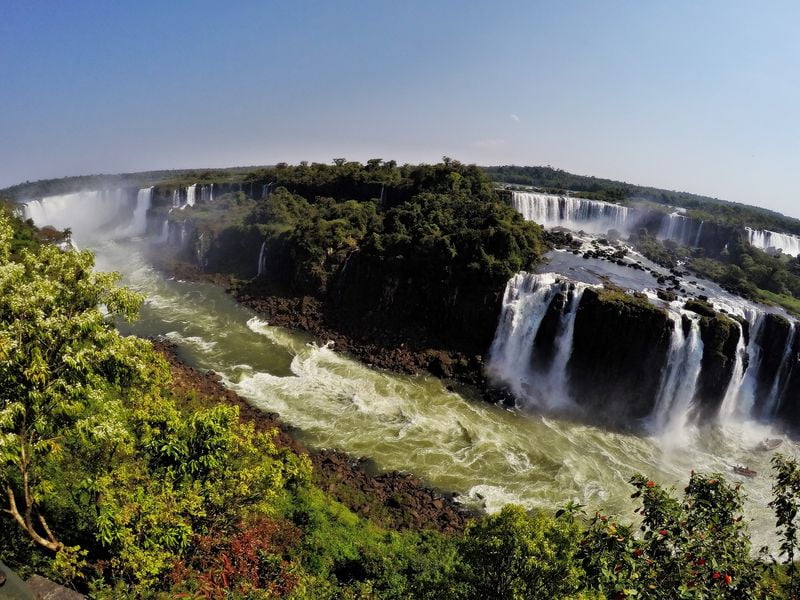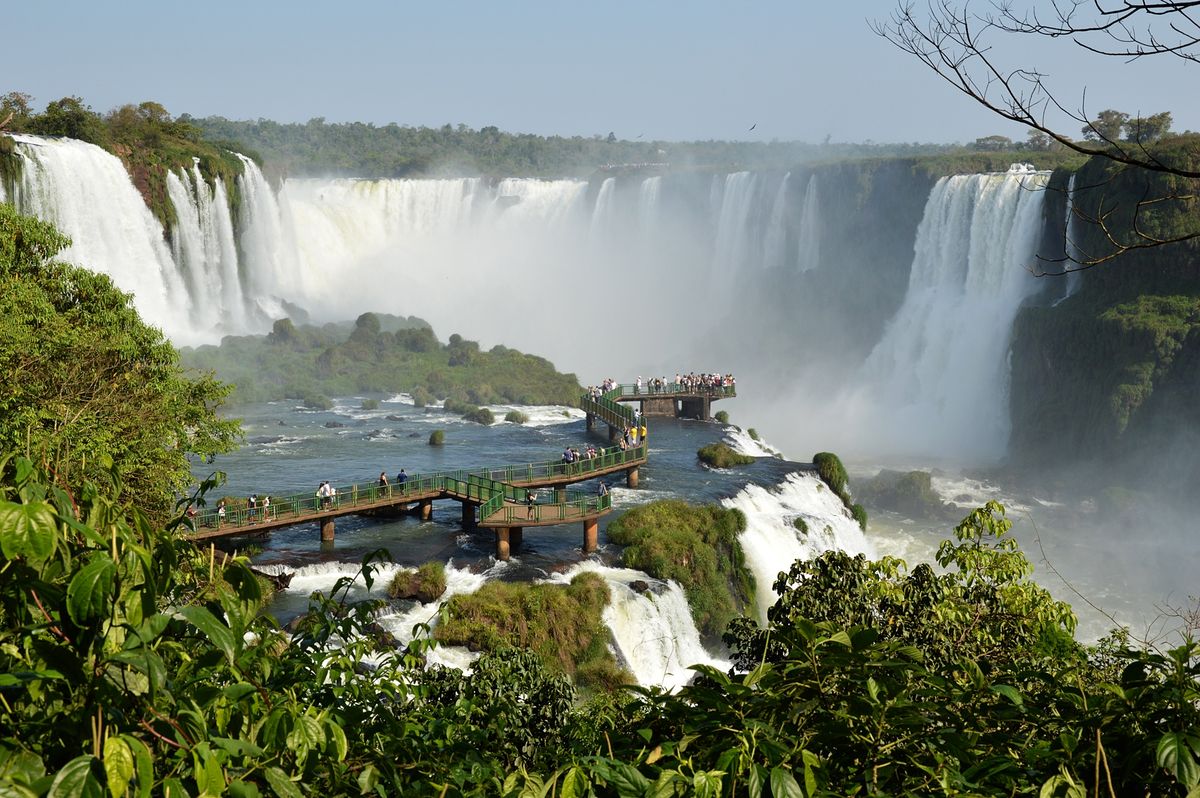The Iguazu Falls stand as one of the most renowned and spectacular waterfalls globally. They earned their place not by being the tallest, widest, or deepest, but by consistently ranking among the top ten most beautiful waterfalls on the planet. The Iguazu National Park holds UNESCO recognition and is regarded as one of the world’s newest natural wonders. In this article, I will guide you through visiting the Iguazu Falls independently from both Argentina and Brazil.
Содержание
- Iguazu Falls on the map
- What’s the Buzz About Iguazu National Park?
- How to get to Iguazu Falls
- Deciding Where to Settle: Puerto Iguazu or Foz do Iguacu?
- Best Time to Explore the Iguazu National Park
- Cost of Visiting Iguazu Falls in 2023
- What to bring on your trip
- Exploring Iguazu Falls: Argentinian Side vs. Brazilian Side
- The History of the Iguazu National Park
Iguazu Falls on the map
Positioned along the Iguazu River, the Iguazu Falls straddle the border between Argentina and Brazil. The majority of the cascades grace the Argentine side, within the province of Misiones, while the other portion lies on the Brazilian side, in the state of Parana.
What’s the Buzz About Iguazu National Park?
Imagine a grand display of over 270 waterfalls curving gracefully along the meandering path of the Iguazu River. The largest of these is the mighty Garganta del Diablo. It is a colossal waterfall standing at a jaw-dropping height of more than 80 meters and stretching out to a width of approximately 150 meters.
But that’s not all. Iguazu National Park isn’t just about the spectacular waterworks. It’s a home for an astounding array of plant and animal species. Monkeys swinging through the treetops, stealthy cougars prowling the forest, and colorful birds are soaring in the sky.

In 1984, the Iguazu Falls earned a place on the UNESCO World Heritage List. Later, in 2011, these falls have taken their place among the New Seven Wonders of the World. It’s no wonder that Iguazu National Park is on the bucket list of every true explorer.
Check out my other article: Experiencing Canada’s Niagara Falls in Winter
So, how can you visit this gorgeous place independently?
How to get to Iguazu Falls
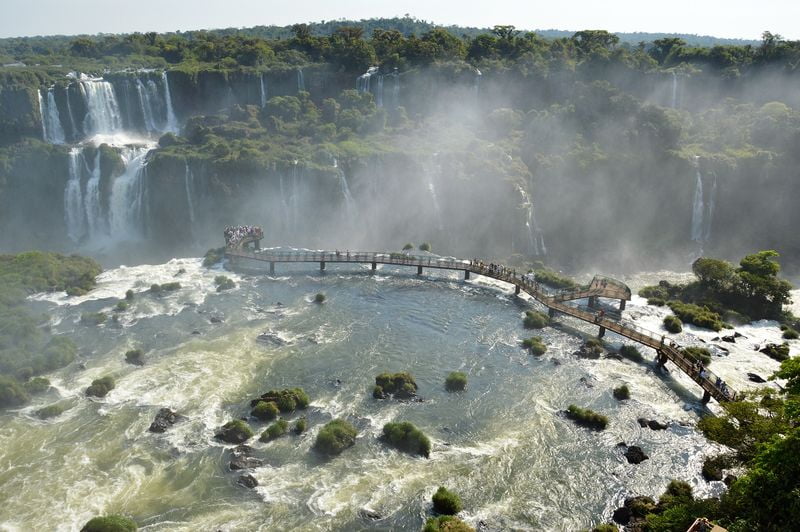
As previously mentioned, Iguazu National Park spans two nations: Argentina and Brazil. Most of the foreigners don’t need a visa to enter both of this countries. However, travelers from the United States must obtain a visa to enter Brazil.
For those exploring the Argentine side, the starting point is the city of Puerto Iguazu, whereas for the Brazilian side, it’s Foz do Iguacu. The city of Ciudad del Este in Paraguay lies relatively nearby. It houses an airport and buses connecting to Iguazu Falls.
You can purchase flight tickets to a suitable airport with a two-day gap and embark on a day trip to the neighboring country. Unless you plan to continue your journey through another country, it’s advisable not to buy tickets from different airports. An added benefit is avoiding the costly luggage storage at the national park.
Taking the bus from Puerto Iguazu to either side of the national park costs $6-10 at the official exchange rate. Due to Argentina’s volatile economic situation, prices are subject to change. The bus station is centrally located, and multiple companies operate. I chose the Rio Uruguay bus company as the cheapest one. Buses depart every 20 minutes.
Bus №120 from Foz do Iguaçu’s downtown to the park costs approximately $1.
I recommend allocating a full day for each park. While it is possible to visit both sides in one day, it is too much of a hussle.
Getting to Puerto Iguazu (Argentina)
The most convenient way to reach the falls is to fly from Buenos Aires. A flight takes a mere two hours, while a bus journey consumes a lengthy 16 hours. Airline options include Aerolineas Argentinas and Jet Smart, with one-way fares ranging from $70 to $100 (possibly lower).
Getting to Foz do Iguaçu (Brazil)
Opting for the budget-friendly route from Brazil, flights from Sao Paulo are your best bet. One-way tickets also amount to around $100. Alternatively, a bus journey is possible, though it spans a duration of 19 hours.
Tours to Iguazu Falls from Buenos Aires
Deciding Where to Settle: Puerto Iguazu or Foz do Iguacu?
Pondering over Puerto Iguazú versus Foz do Iguacu? The truth is, the choice isn’t earth-shattering. Tourist-oriented bus services link the two cities, although you will need to pass through immigration and acquire a stamp.
Accommodation in Puerto Iguazu starts from $10 for a hostel bed, and from $18 for a basic double room with a kitchen. A good hotel might range between $35 and $40. Generally, Argentina tends to be more budget-friendly than Brazil, and the town itself possesses a more charming appeal, at least from my perspective.
Best Time to Explore the Iguazu National Park
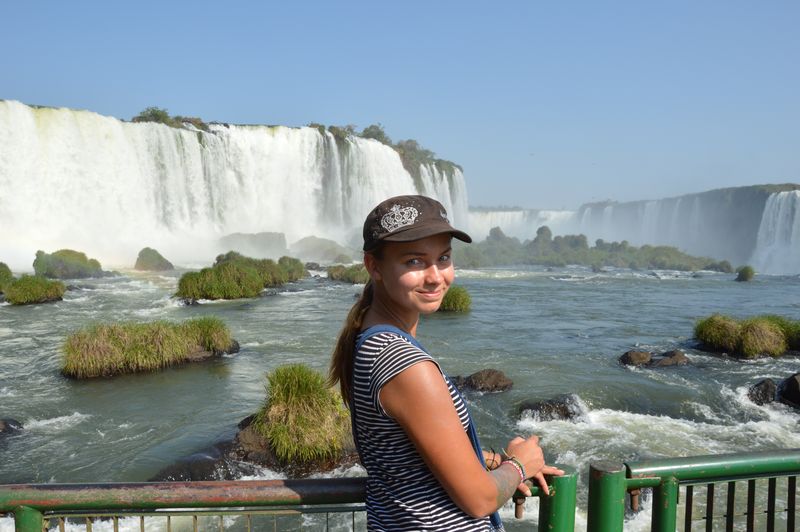
🌦️ The months of November through March mark the rainy season. It is a time when the waterfalls don their vibrant crimson robes. Yet, the relentless downpours and somber skies might slightly dim the splendor.
☀ From May to August, the weather is ideal, with moderate temperatures and abundant, pristine water flow.
🔥The Southern Hemisphere’s summer is from December to February. It is the hottest and driest time of the year. While the waterfalls might not be at peak volume, unless faced with an extraordinary drought like the one in 1978 when they dried up for a month, water availability is generally abundant.
I visited the Iguazu Falls at the end of September.
Cost of Visiting Iguazu Falls in 2023
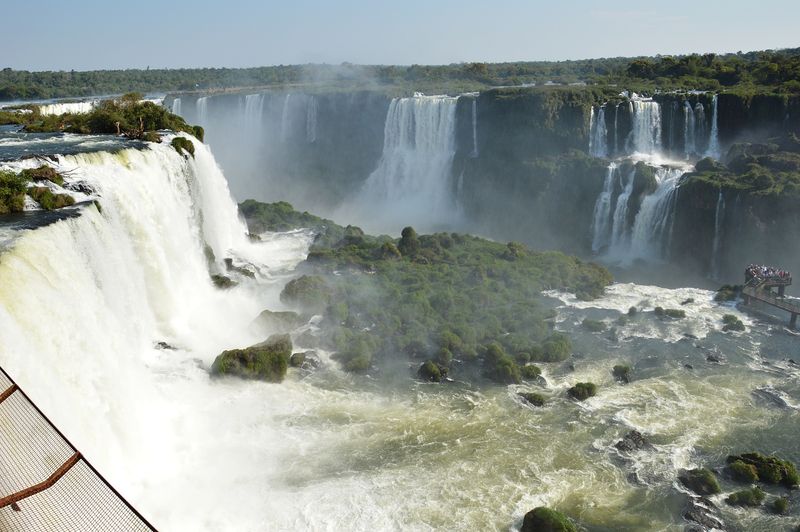
Prices on the Argentinian Side
The entrance fee for Iguazu Falls from Argentina is 10,000 ARS ($35). Children aged 6 to 16 are charged 5,000 ARS ($18). Argentine residents pay a reduced rate of 2500 ARS. Given Argentina’s economic challenges, these prices are subject to change.
Heads up!! The official website states that tickets are exclusively available for purchase online. The ticket must be printed; on-the-day box office purchases are not possible. Nonetheless, recent visitors to Iguazu report a separate ticket office for walk-ins.
Operating hours are from 8:00 to 18:00, with the last entry permitted at 16:30.
Both sides of the park offer an array of activities. The highlights include heart-pounding boat rides beneath the falls and exhilarating helicopter flights.
🤫 Here’s a little secret. Helicopter flights are more economical in Brazil, while boat rides are more budget-friendly in Argentina. This discrepancy arises because all helicopter pads are situated in Brazil. Consequently, the tours offered in Argentina include the fare of a Brazilian company, along with marked-up prices for guiding and taxi services. The most affordable helicopter flight I found in Argentina was priced at $335 (no peso payment option). However, you can secure a boat trip using Argentine pesos, allowing you to save nearly 50% thanks to exchange rate differentials.
I delve further into Argentina’s unique economic situation and the dual exchange rate in a separate article: Buenos Aires: Money, Accommodation, and Life Hacks.
Boat Ride Under the Waterfalls
On the Brazilian side, booking a boat trip through the Macuco Safari costs $83. However, opting for the same tour in Argentina through Iguazu Jungle (also known as Gran Aventura) is much more cost-effective. This option is priced at 22,000 Argentine pesos or $78 (as of July 2023). If paid in cash at the unofficial exchange rate, significant savings can be realized.
Prices on the Brazilian Side
The admission fee for accessing the park from the Brazilian side is 83 reais ($17) for foreign visitors and 75 reais ($16) for Brazilian citizens. These tickets can be conveniently purchased online through the official website.
The park welcomes visitors from 9:00 AM to 6:00 PM, with the last entry permitted at 4:00 PM. On Saturdays and Sundays, the park opens half an hour earlier.
Bus №120 departs from the center of Foz do Iguaçu, and costs under $1. For those arriving from Argentina, a one-way trip across the border will cost 6 to 10$.
Insider Tip: If you’re driving your own car to the park, here’s a nifty trick. You can save on parking fees by leaving your car at the bird park’s parking lot for just 25 reais. In contrast, parking at the park’s entrance carries a higher cost of 50 reais!
Helicopter flight over the Iguazu Falls
A helicopter flight from Helisul cost $120 (580 reais) in July 2023. The company’s Instagram now lists a slightly higher price of 610 reais ($125). The flight lasts 10-12 minutes.
You need to come to the office of the company, which is located near the entrance to the national park and stand in a live queue. Office hours are from 9:00 to 17:00. The company does not sell tickets for a specific time, and if you see such offers on the Internet, do not believe it. For example, you can purchase the same ticket online from the Viator website. It guarantees you a flight on the selected date, BUT not at the selected time (although you will be prompted to select a flight time when booking).
Combined tour
If you do not want to book all tours on your own, then check out this tour on the Viator website. It has very good reviews. The tour offer a package with the most worthwhile entertainment. They don’t sell you guided jungle trekking (actually a regular walk along the park trails) and other boring stuff. Of course, this package is more expensive than booking these experiences separetely, but it will also saves you time.
The tour includes:
- a visit to the Bird park (without a tour the entrance costs 80 reais / 16$). It is a cool place where you can see tropical birds up close;
- a helicopter flight (580 reais / 120$);
- a boat trip (386 reais / 80$). The price includes transportation from the hotel to Foz do Iguacu and back. For an additional 20$ you can order a pickup and drop off from Puerto Iguazu. Please note that the entrance to the park is not included in the price.
What to bring on your trip
- Passport. You’ll need your passport to cross the border. Verify that all necessary entry and exit stamps are in place.
- Cash. Card payments might not be accepted at the ticket counters in Argentina. In Brazil, card usage might be restricted to tickets, not luggage room. While ATMs are available, be prepared for long queues.
- Camera and Protective Bag. Don’t forget your camera to capture the breathtaking sights. Pack it in a plastic bag to shield it from any splashes.
- GoPro Camera. Consider bringing a GoPro camera for its waterproof capabilities, especially for the water-based adventures.
- Raincoat. If you prefer to stay dry under the spray, grab a raincoat. However, on a hot day getting a little wet is such a joy!
- Sun Protection. Equip yourself with sunglasses, sun cream, and a sun hat.
- Lunch. Since there are no cheap restaurants on-site, be sure to pack your lunch. The small stalls in the national park primarily offer sandwiches at inflated prices.
- First Aid. Bring along band-aids and bandages, especially if you’re tempted to interact with coatis. These curious critters may nibble, and it’s good to be prepared.
For more travel insights, read: What to Pack for Your Journey? A Comprehensive Overview of My Backpack.
Exploring Iguazu Falls: Argentinian Side vs. Brazilian Side
In my eyes, both sides of the Iguazu Falls offer distinct experiences and are equally worth visiting. The waterfalls on the Brazilian side can be explored in about 2-3 hours. The Argentinean side requires around 5 hours to visit due to its expansive terrain.
Waterfalls on the Brazilian Side
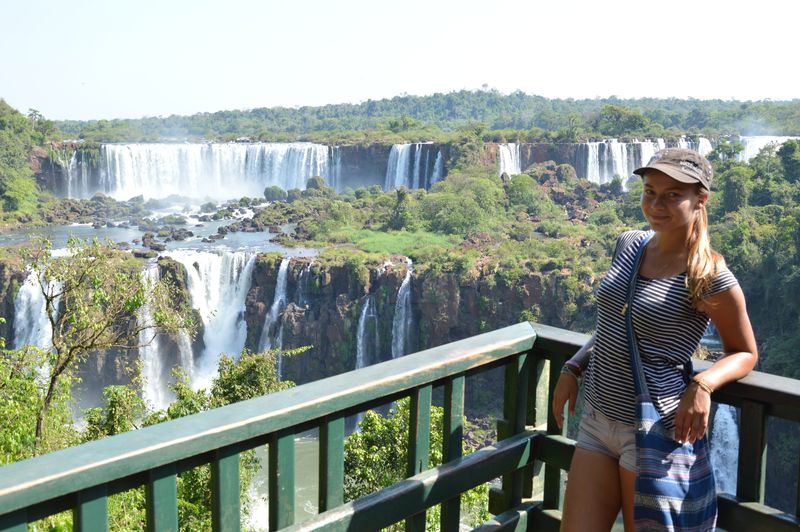
Upon arriving at the entrance gate, you’ll need to transfer to the complimentary green bus. It will take you directly to the viewing area. Walking isn’t necessary, as the waterfalls remain concealed from view throughout the journey.
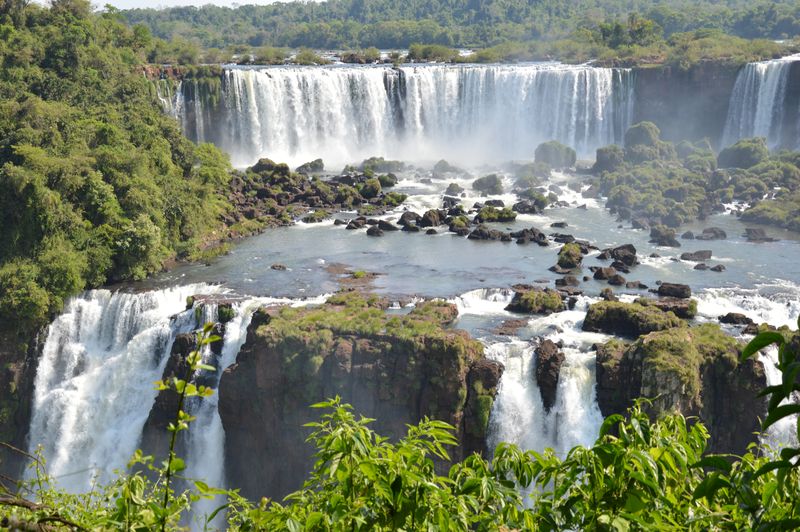
The Brazilian side boasts a single observation deck without hiking trails or additional attractions. Nevertheless, the panoramic view of the Iguazu Falls from this vantage point is unparalleled and distinct from the view in Argentina. The Brazilian observation deck is situated slightly lower, providing a face-to-face encounter with the most powerful cascades in the park. In contrast, the Argentinean side offers a top-down perspective.
Despite the smaller size of the Brazilian park, I captured some of the most stunning photos there.
Waterfalls on the Argentintinian Side
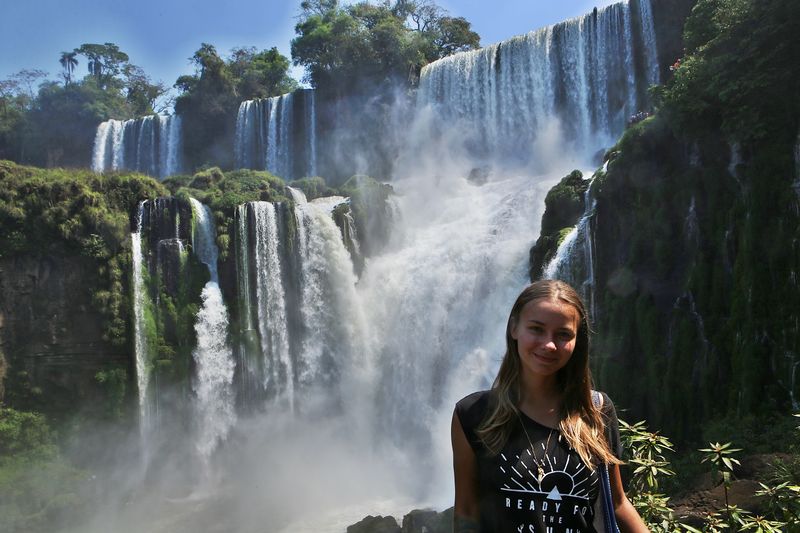
The Argentinean section of the waterfalls encompasses an expansive park featuring six distinct routes. These trails wind along various waterfalls, ranging from small cascades to the most awe-inspiring torrents. Remarkably, a staggering 80% of all the waterfalls are located on the Argentine side! You’ll have the opportunity to marvel at tropical birds, playful monkeys, and curious coatis.
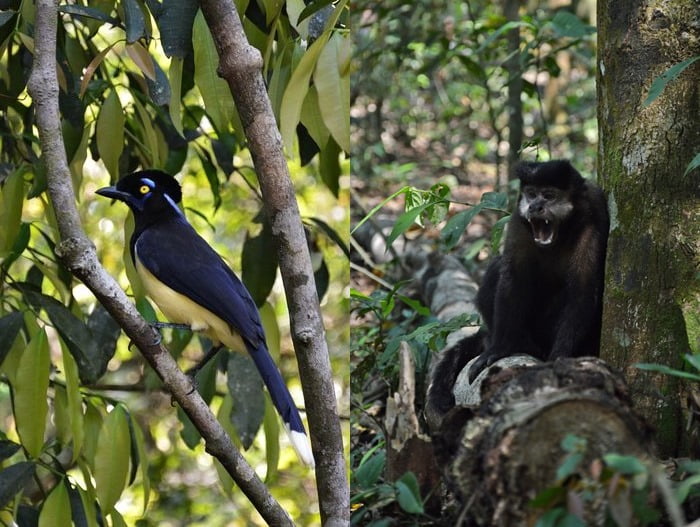
Coati raccoons show no fear of human presence, while keeping an eye on bags of food. These clever creatures have been known to open even the most intricate locks! It’s advisable not to feed them by hand to avoid potential bites.
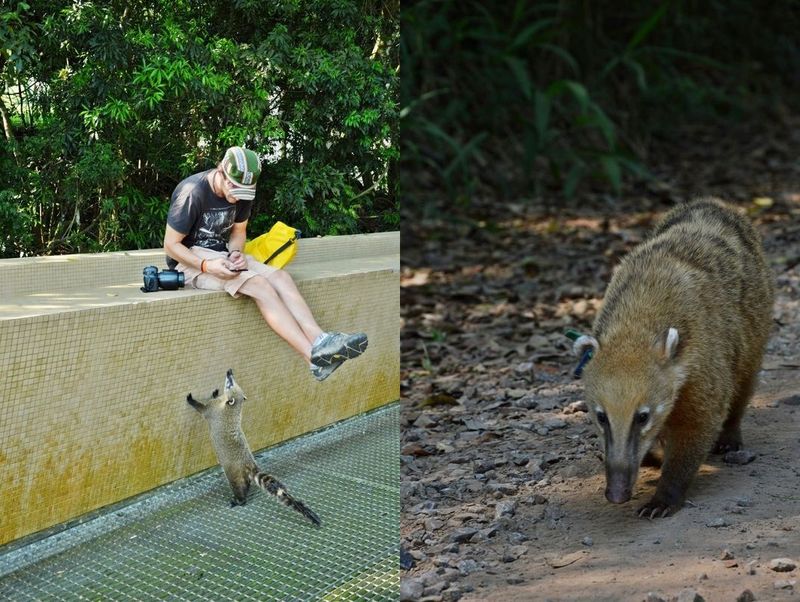
The park provides free drinking water fountains, that you’ll undoubtedly value under the scorching sun.
A journey to the waterfalls commences within the heart of the tropical jungle. There wild orchids grace the trunks of trees, and monkeys dangle from branches above. The air carries an enchanting bouquet of unfamiliar floral fragrances.
Undoubtedly, the highlight of the Argentinean side of Iguazu National Park is the breathtaking view of the Devil’s Throat. Standing at the precipice, you’ll feel as though you’re nearly engulfed by the thundering rush of water! While the observation deck often bustles with visitors, the crowds eventually disperse, allowing you to explore the vast expanse of the park.
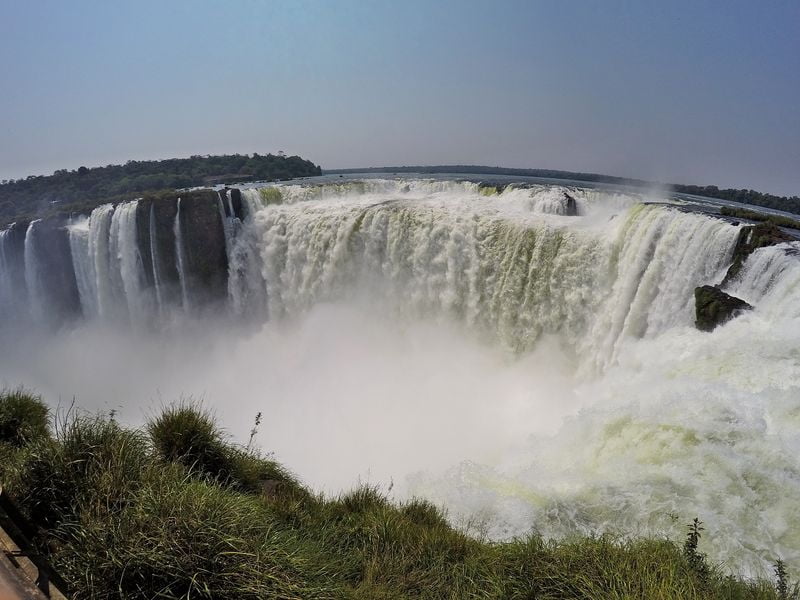
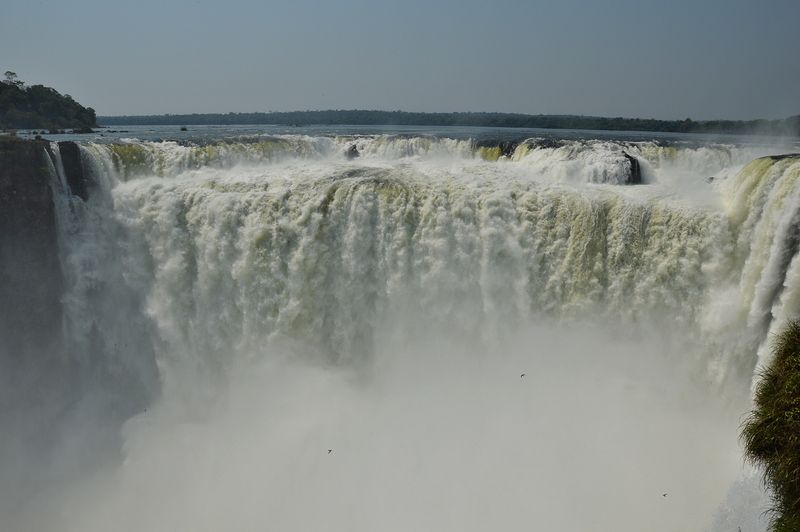
The History of the Iguazu National Park
The jungle of Iguazu Park has been inhabited for over 10,000 years. Around 1000 BC, the Guarani Indians supplanted other indigenous communities within the selva. They established their dominance over the jungle until the 16th century when the Spanish arrived.
In 1542, the expedition led by Alvar Nunez, known as “Cabeza de Vaca” (Cow’s Head), ventured into the Amazonian jungle. He succinctly labeled the falls as “significant” and dispatched missionaries to the selva to civilize the native inhabitants. By 1609, the first Jesuit missions settled in the jungle. They achieved considerable autonomy from the governing authorities. Nonetheless, these missions were eventually banished from the region 150 years later.
Tourist excursions to the Iguazu Falls emerged during the 1890s. Argentina designated the Iguazu national park in 1909, with Brazil following suit in 1939.
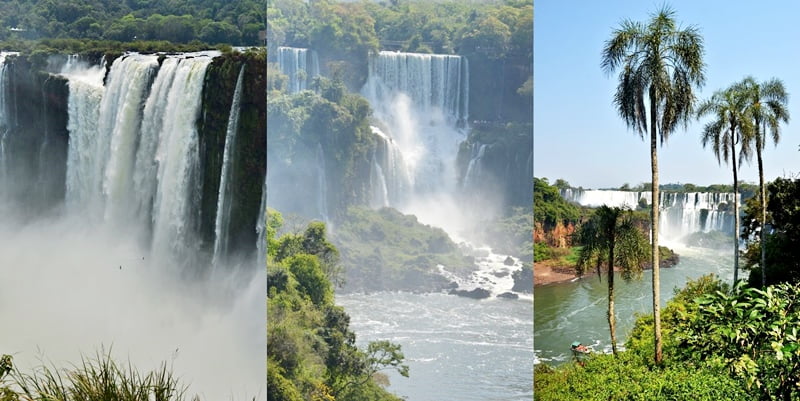
In 1986, the entirety of the park earned recognition on UNESCO’s heritage list. Subsequently, in 2011, Iguazu secured victory in the “7 Natural Wonders of the World” competition. It gathered the vote of over 100 million people worldwide who weighed the merits of 440 attractions spanning 220 countries.
“Iguazu,” derived from the Guarani language, translates to “Big Water.” Notably, a significant portion of the waterfalls has been harnessed for energy generation. Collaboratively, Brazil and Paraguay erected one of the globe’s largest hydroelectric power plants, Itaipu.
